What if you found out your neighbourhood public park may not be as welcoming as you thought?
Over a few weekends in June, teams of volunteers set out to discover and map the unwelcoming features of our public spaces. Armed with smart phones and GPS, participants ventured out into neighbourhoods across Toronto to snap pictures of “defensive urban design” to add to a new interactive map as part of the public space project called Mapping DefensiveTO.
Also known as hostile, unpleasant, or exclusive architecture, defensive urban design uses elements in the built environment to guide or restrict behaviour in public space as a form of crime prevention or order maintenance. It’s an intentional design strategy that affects individuals who use or rely on public space the most, such as people who are houseless and youth. From benches with a centre bar installed to keep people from lying down to ledges fortified with anti-skateboard deterrents, defensive urban design can be found all over Toronto and in many cities across the country.
While the terms “defensive” and “hostile” design are relatively new, the use of the built environment for social and spatial control is not. From city walls to spiked fences, there is a long history of architecture used to fortify cities, protect property, and to keep people out. Today’s forms of defensive urban design are influenced by Oscar Newman’s work on Defensible Space. Newman developed the idea that crime can be controlled through the design of the built environment and believed that residents could be empowered to defend their neighbourhood spaces by creating opportunities for surveillance and increasing a sense of ownership of common space.
This laid the groundwork for design philosophy Crime Prevention through Environmental Design (CPTED). CPTED uses design strategies like natural surveillance, natural access control, and territorial reinforcement to reduce real and perceived crime. It is often paired with strict policing policies influenced by James Wilson and George Kelling’s broken windows theory, based on the belief “that if a window in a building is broken and is left unrepaired, all the rest of the windows will soon be broken.” According to this line of thought, if small crimes and signs of disorder are not addressed, more serious crimes will flourish.
Today’s ubiquitous forms of defensive urban design differ from historical forms because they are found in public spaces that are meant to be accessible and inclusive. While it’s all around us, defensive urban design is often hidden in plain view. Its coercive functions or “silent agents” are concealed within more socially acceptable features. For example, a bench designed to keep people from lying down still allows for the function of sitting. Although many people may not notice defensive urban design in their daily lives, it has become so common in Toronto that such elements are even included in architectural renderings of future public spaces. This one-size-fits-all solution to crime prevention and order maintenance means that defensive design features are often installed in new public spaces before any spatial issues or conflicts arise.
Mapping DefensiveTO is the first undertaking to systematically map defensive urban design in Toronto’s public parks, squares, and privately owned publicly-accessible spaces (POPS). The project aims to raise awareness over the proliferation of defensive urban design in Toronto while gathering data over its use in publicly accessible spaces. The map allows people to discover a new layer to their city that they may not have noticed before, and invites residents to re-think how their public spaces are designed, and for whom.
The volunteers who took part in the group mapping activities learned how to spot the most common forms of defensive architecture: modified seating to keep people from staying too long or lying down; ledges with anti-skateboard deterrents; barriers placed in alcoves to keep people from seeking refuge; surface treatments that make residual spaces uninhabitable; signs of surveillance; and the lack of public amenities like washrooms, water fountains, benches, and shade.
Less common examples include the use of light and sound. Light can serve as a deterrent, depending on its brightness and quality. For example, blue lights are often found in public washrooms because they prevent intravenous drug users from finding veins and pink light has been spotted in the UK as a way to move along loitering youth because it’s thought to amplify the facial blemishes and resulting social discomfort of spotty faced youth.
Sound has also been used to deter unwanted users of space. From children’s songs to classical music, sound has been deployed to keep people from sleeping in public or just hanging out. A few years ago, the Mosquito, an anti-loitering device that emits an irritating, high pitched noise at a frequency that only young ears (and people) could hear, was spotted in a downtown Toronto park, close to a nearby youth shelter. While the device was removed after its use made media headlines, there are concerns that this sonic weapon can cause hearing damage.
Although defensive architecture often targets “undesirable” behaviours such as sleeping in public or skateboarding, it also creates a hostile cityscape for everyone else. The absence of public amenities like washrooms, benches, and places of shade/shelter makes navigating public space difficult or impossible for vulnerable citizens — those who are elderly, people, with a disability; individuals who are ill, and families with young children. This absence — i.e., ghost amenities — is often deliberate and done as a way to reduce maintenance costs, deter loitering, and avoid vandalism. Furthermore, the addition of defensive elements like metal studs installed on ledges to prevent skateboarding can be a hazard for people who accidentally sit or trip over them.
Defensive architecture also creates spaces that are overly rigid and inflexible. For example, benches installed with a centre bar are restrictive in more ways than one. They limit seating capacity to two adults while standard benches can accommodate more people sitting comfortably. Designing flexibility into public amenities and spaces is increasingly important in a city like Toronto, which is playing catch-up to provide enough open space for current and future residents.
Many cities are also undertaking placemaking projects to make public spaces more attractive or desirable. One would think that providing welcoming places for people to sit, relax, and watch the world go by would be a central goal. Yet public spaces become less inviting when they feature defensive elements, such as ledges that serve as seating areas that are fortified with metal studs.
Finally, defensive architecture signals to targeted populations — people who are houseless, skateboarders, or rowdy teenagers — that they are not welcome in that space. Other people may not notice such design cues, but those targeted certainly do. Many people may adapt to places designed against them. People sleep sitting up, skateboarders skate around deterrents, and teenagers ignore surveillance cameras or piped-in classical music meant to make them feel out of place.
So given that defensive urban design is being used in many new and redeveloped public spaces in the GTA, what are we to do?
The first step is to create a dialogue between conflicting user groups and develop an understanding that all people deserve respect and dignity when accessing public space. We can also ask municipalities to examine their use of defensive architecture and develop explicit guidelines to ensure its future use is fair and transparent. Conflict is inevitable, but how we deal with it, is not. Rather than continuing to create spaces that cater to an idealized notion of “the public,” let’s make spaces for all those people who is already here.
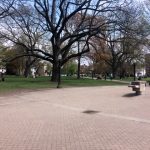 An example of “ghost amenities” in Allan Gardens. The benches that once lined the square were removed due to vandalism and from complaints from the community. The commemorative water fountain is in disrepair.
An example of “ghost amenities” in Allan Gardens. The benches that once lined the square were removed due to vandalism and from complaints from the community. The commemorative water fountain is in disrepair.
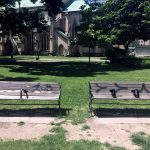 Benches equipped with centre bar, St. James Park.
Benches equipped with centre bar, St. James Park.
 Sign warns of surveillance.
Sign warns of surveillance.
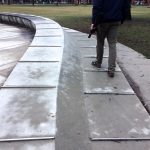 Anti-skateboard deterrents presents a tripping hazard in Grange Park.
Anti-skateboard deterrents presents a tripping hazard in Grange Park.
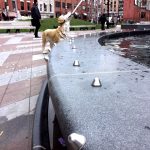 Dog fountain equipped with anti-skateboard deterrents in Berczy Park.
Dog fountain equipped with anti-skateboard deterrents in Berczy Park.
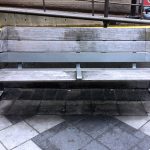 Bench with centre bar near York and Richmond streets.
Bench with centre bar near York and Richmond streets.
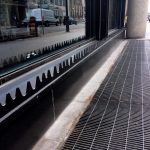 Anti-loitering “spikes” on a window ledge downtown Toronto.
Anti-loitering “spikes” on a window ledge downtown Toronto.
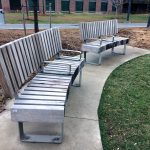 New benches designed with centre bar configuration in Grange Park.
New benches designed with centre bar configuration in Grange Park.
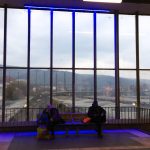 Blue light in a train station in Heidelberg, Germany.
Blue light in a train station in Heidelberg, Germany.
Spot an example of defensive urban design in your neighbourhood? Snap a photo and send it along with location information to defensiveto@gmail.com to add it to the map. Cara Chellew is a researcher and public space advocate based in Toronto. Follow her on twitter at @CaraChellew.

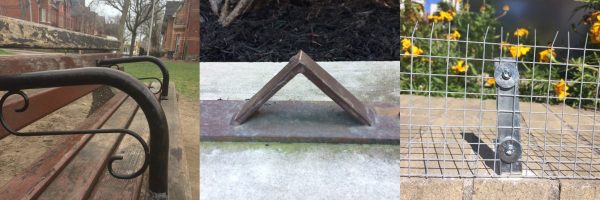



One comment
I see nothing wrong with well designed defensive architecture: good examples being the anti-skateboard metal ‘dots’ around the fountain in Berczy Park. Before they were installed at least one dog was damaged by a thoughtless skate-boarder. I certainly think that any such ‘defences’ need to be well integrated into the area being ‘protected’ – just adding metal spikes to a knee-high window-sill is not acceptable.